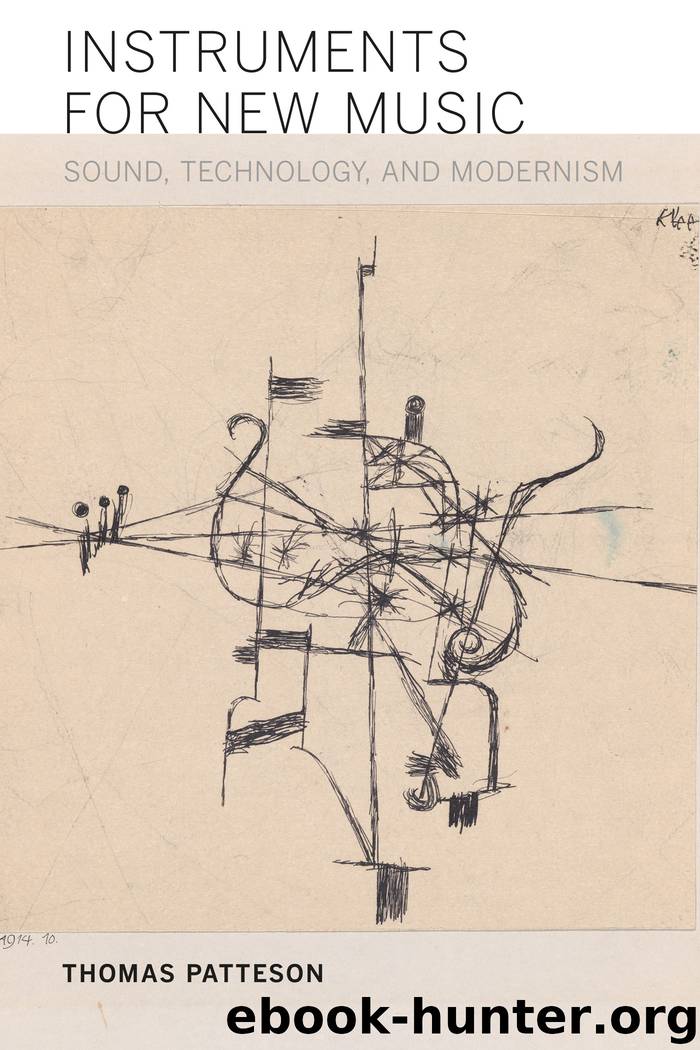Instruments for New Music by Thomas Patteson

Author:Thomas Patteson [Patteson, Thomas]
Language: eng
Format: epub
ISBN: 978-0-520-96312-2
Publisher: University of California Press
Published: 2015-11-19T16:00:00+00:00
FROM LABORATORY TO CONCERT HALL
The late 1920s marked the arrival of what might be called an institutional approach to electric music, with large research teams, interdisciplinary collaboration, and substantial government funding replacing the more informal and ad hoc approach of earlier years. In May 1928, six months before the launch of the Society for Electroacoustic Music in Darmstadt, the Radio Research Section (Rundfunkversuchsstelle) was established at the Berlin Academy of Music with a broad mandate to research topics relating to the new acoustic technologies.26 It was overseen by Georg Schünemann, the associate director of the Academy, a musicologist and administrator who sought to bring the utopian visions of Busoni’s Sketch of a New Aesthetic of Music up to date with the technical possibilities of the 1920s. The goal was to elevate radio to a vehicle of culture (Kulturträger) and forge new channels of artistic experience fit for a mass society. Expressing the quasi-political hopes attached to the new medium, the scholar Arno Schirokauer declared in 1929 that with the advent of radio, “art has been socialized. From private ownership it has become everyone’s possession.”27 Such claims mixed genuine sentiments of cultural populism with ignorance of the obstacles, from commercialization to government censorship, that stood in the way of a truly democratic mode of cultural production.28
Because it was housed in a major conservatory, the Radio Research Section could take advantage of the musical resources at its disposal: various choral, orchestral, and chamber music groups; a massive collection of musical instruments; and an archive of over ten thousand ethnomusicological recordings.29 Its curriculum featured courses in funkisches Sprechens (speaking on radio) for would-be broadcasters, speech and gesture for film actors in training, sound-film recording techniques, and composition seminars geared toward writing for radio and motion pictures. The group’s activities also touched on new pedagogical uses of radio technology: in 1932 it began broadcasting some of its classes via shortwave radio—a brief but prophetic experiment in “wireless education.”30
Also in 1928, the Heinrich Hertz Institute for Oscillation Research was founded at the Berlin Institute of Technology (Technische Hochschule). Its director was Karl Willy Wagner, the engineer and acoustician whose research on electroacoustic filters had influenced both Mager and Trautwein. The broad remit of the HHI encompassed all vibratory phenomena, from acoustics to radio and telephony. Although it was more technically oriented than its counterpart at the Academy of Music, the two institutions were closely linked, and both were involved in the research and development of electric instruments. Fundamental to both was the goal of collapsing the distance between productive and reproductive technologies—instruments and media—through the close collaboration of artists and technologists.
Trautwein was appointed as a lecturer in acoustics at the Academy of Music in 1930 and immediately began working in the studio of the Radio Research Section.31 There he found a valuable collaborator in Paul Hindemith, who had taught composition and film music at the Academy since 1927.32 Hindemith, who had previously extolled Jörg Mager’s instruments, was quickly won over to Trautwein’s cause, and even had a hand in the Trautonium’s design.
Download
This site does not store any files on its server. We only index and link to content provided by other sites. Please contact the content providers to delete copyright contents if any and email us, we'll remove relevant links or contents immediately.
The Goal (Off-Campus #4) by Elle Kennedy(13220)
Kathy Andrews Collection by Kathy Andrews(11360)
Diary of a Player by Brad Paisley(7276)
What Does This Button Do? by Bruce Dickinson(5942)
Assassin’s Fate by Robin Hobb(5873)
Big Little Lies by Liane Moriarty(5532)
Altered Sensations by David Pantalony(4882)
Pale Blue Dot by Carl Sagan(4650)
Sticky Fingers by Joe Hagan(3922)
The Death of the Heart by Elizabeth Bowen(3355)
The Heroin Diaries by Nikki Sixx(3339)
Beneath These Shadows by Meghan March(3162)
Confessions of a Video Vixen by Karrine Steffans(3118)
The Help by Kathryn Stockett(3024)
How Music Works by David Byrne(2976)
Jam by Jam (epub)(2889)
Harry Potter 4 - Harry Potter and The Goblet of Fire by J.K.Rowling(2830)
Strange Fascination: David Bowie: The Definitive Story by David Buckley(2706)
Petty: The Biography by Warren Zanes(2583)
